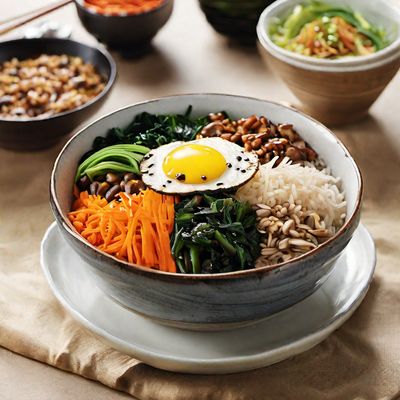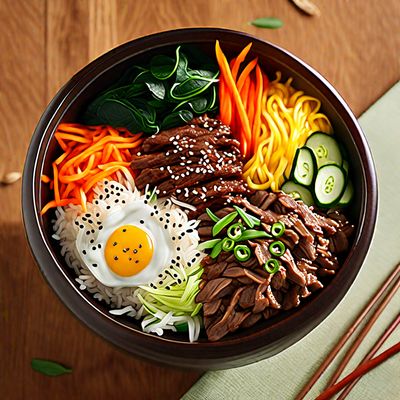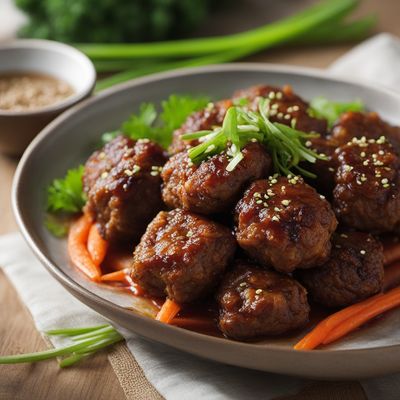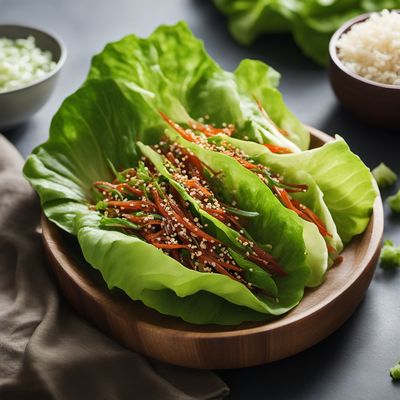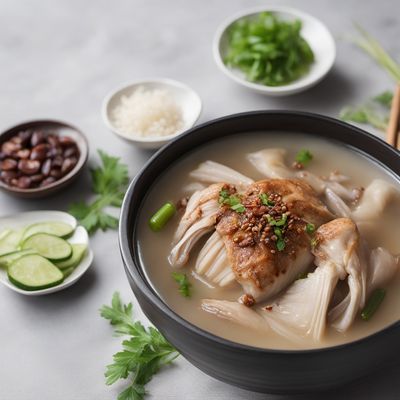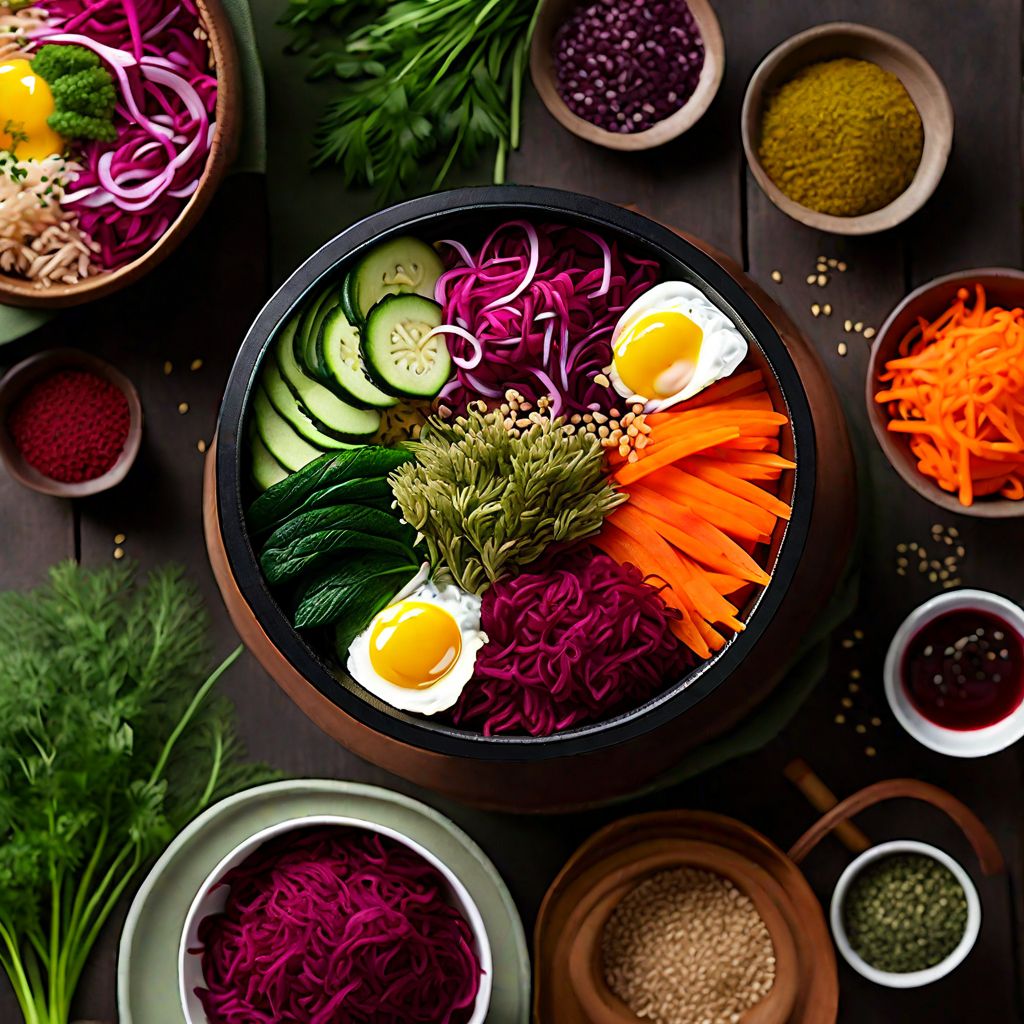
Recipe
Latvian-style Bibimbap
Riga Bibimbap: A Fusion of Korean and Latvian Flavors
4.8 out of 5
In the context of Latvian cuisine, this recipe brings a unique twist to the traditional Korean dish, Bibimbap. By incorporating local ingredients and flavors, we create a delightful fusion that combines the vibrant colors and textures of Bibimbap with the rich culinary heritage of Latvia.
Metadata
Preparation time
20 minutes
Cooking time
15 minutes
Total time
35 minutes
Yields
4 servings
Preparation difficulty
Easy
Suitable for
Vegetarian, Gluten-free, Dairy-free, Nut-free, Low-fat
Allergens
Mustard
Not suitable for
Vegan, Paleo, Keto, High-protein, Low-carb
Ingredients
While the original Bibimbap is typically made with Korean ingredients such as gochujang and kimchi, this Latvian adaptation incorporates local produce and flavors. We substitute gochujang with a tangy Latvian mustard sauce and replace kimchi with pickled Latvian vegetables. These changes infuse the dish with a distinct Latvian twist. We alse have the original recipe for Bibimbap, so you can check it out.
-
2 cups (470ml) cooked barley 2 cups (470ml) cooked barley
-
1 cup (235ml) cooked beets, julienned 1 cup (235ml) cooked beets, julienned
-
1 cup (235ml) cooked carrots, julienned 1 cup (235ml) cooked carrots, julienned
-
1 cup (235ml) cooked zucchini, julienned 1 cup (235ml) cooked zucchini, julienned
-
1 cup (235ml) cooked mushrooms, sliced 1 cup (235ml) cooked mushrooms, sliced
-
1 cup (235ml) cooked spinach 1 cup (235ml) cooked spinach
-
1 cup (235ml) pickled Latvian vegetables (cabbage, cucumbers, etc.) 1 cup (235ml) pickled Latvian vegetables (cabbage, cucumbers, etc.)
-
1 cup (235ml) Latvian mustard sauce 1 cup (235ml) Latvian mustard sauce
-
4 eggs 4 eggs
-
Salt and pepper to taste Salt and pepper to taste
-
Fresh dill for garnish Fresh dill for garnish
Nutrition
- Calories (kcal / KJ): 320 kcal / 1340 KJ
- Fat (total, saturated): 5g, 1g
- Carbohydrates (total, sugars): 60g, 10g
- Protein: 10g
- Fiber: 8g
- Salt: 1g
Preparation
-
1.Preheat the oven to 180°C (350°F).
-
2.In a large bowl, combine the cooked barley, beets, carrots, zucchini, mushrooms, and spinach.
-
3.Season the mixture with salt and pepper to taste.
-
4.Transfer the mixture to a baking dish and bake for 15 minutes, or until heated through.
-
5.In the meantime, fry the eggs sunny-side up in a separate pan.
-
6.Once the barley mixture is heated, remove it from the oven and divide it into serving bowls.
-
7.Top each bowl with a fried egg and a generous amount of pickled Latvian vegetables.
-
8.Drizzle Latvian mustard sauce over the dish and garnish with fresh dill.
-
9.Serve immediately and mix all the ingredients together before eating.
Treat your ingredients with care...
- Barley — Make sure to cook the barley until it is tender but still slightly chewy.
- Latvian mustard sauce — Adjust the amount of mustard sauce according to your taste preference. Add more for a spicier flavor.
- Pickled Latvian vegetables — Feel free to use a variety of pickled vegetables such as cabbage, cucumbers, or radishes for added flavor and texture.
Tips & Tricks
- To add a Latvian touch, you can sprinkle some crispy bacon or smoked fish on top of the Bibimbap.
- Experiment with different Latvian vegetables for pickling to create unique flavors.
- If you prefer a vegetarian version, omit the eggs and add some roasted sunflower seeds for extra crunch.
- Feel free to adjust the amount of Latvian mustard sauce to suit your taste buds.
- Serve the Riga Bibimbap with a dollop of sour cream on the side for a creamy twist.
Serving advice
Serve the Latvian-style Bibimbap hot and mix all the ingredients together before eating. This dish is best enjoyed fresh and can be served as a main course for lunch or dinner.
Presentation advice
For an appealing presentation, arrange the colorful julienned vegetables in a circular pattern on top of the barley mixture. Place the fried egg in the center and drizzle the Latvian mustard sauce over the dish. Garnish with fresh dill for a pop of green.
More recipes...
For Bibimbap » Browse all
For Korean cuisine » Browse all
More Korean cuisine dishes » Browse all

Miyeokguk
Seaweed soup
Miyeokguk is a traditional Korean soup made with seaweed and beef broth. It is often served on birthdays and after giving birth as it is believed...

Kkori gomtang
Ox bone soup with oxtail
Kkori gomtang is a traditional Korean soup that is made with beef bones and vegetables. The soup is known for its rich and savory flavor, and is...

Oiseon
Stuffed Cucumber
Oiseon is a Korean dish made with thinly sliced beef and vegetables.
More Latvian cuisine dishes » Browse all

Rupjmaize
Rupjmaize is a traditional Latvian rye bread that is made with a sourdough starter and often includes caraway seeds. It has a dense texture and a...

Resi
Resi is a Sri Lankan dish made with rice and coconut milk. It is a creamy and flavorful dish that is often served at special occasions.

Sīpolu sitenis
Onion stew
Sīpolu sitenis is a traditional Latvian dish made with potatoes and onions. It is a hearty and filling meal that is perfect for cold winter nights.
